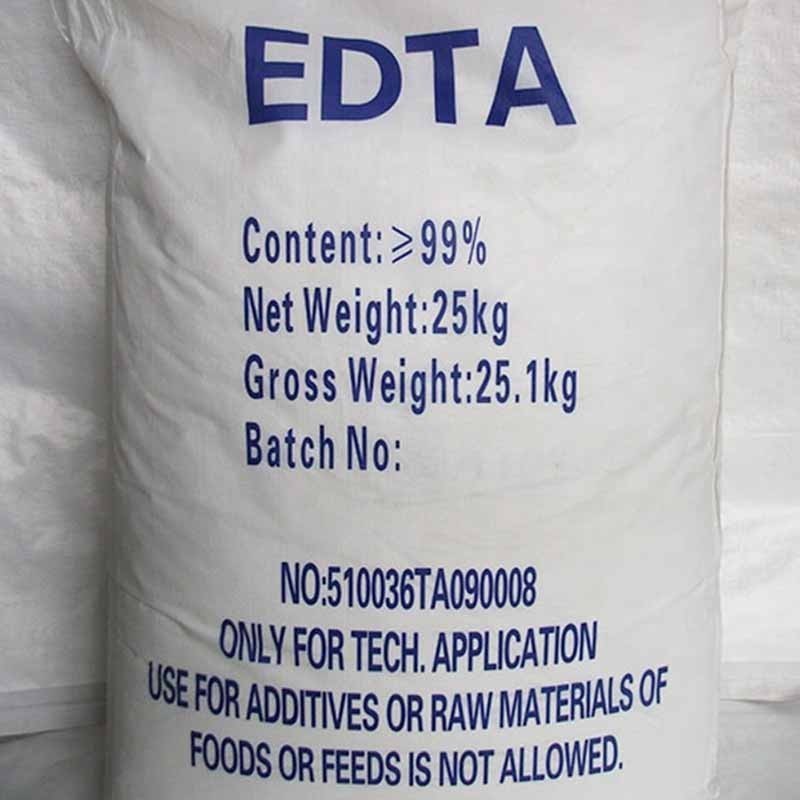
EDTA হল একটি রাসায়নিক যা খনিজ এবং ধাতু যেমন ক্রোমিয়াম, লোহা, সীসা, পারদ, তামা, অ্যালুমিনিয়াম, নিকেল, জিঙ্ক, ক্যালসিয়াম, কোবাল্ট, ম্যাঙ্গানিজ এবং ম্যাগনেসিয়ামকে আবদ্ধ করে এবং ধরে রাখে। যখন তারা আবদ্ধ হয়, তারা শরীরের উপর কোন প্রভাব ফেলতে পারে না এবং তারা শরীর থেকে সরানো হয়।
This is a lab-grade chemical ideal for school, college, university science lab, and analytical institute.
| Grade | Technical Grade |
| Packaging Type | Bag |
| Physical State | Powder |
| Usage/Application | Industrial use |
| CAS Number | 6381-92-6 |
| Chelation Value | 260 - 270 mg/gm. of CaCo3 |
| Molecular weight | 372.24 g/mol (Dihydrate) |
| Assay | 99% (Minimum) |
| Molecular Formula | Na2 EDTA 2H2O (C10H14N2Na2O8) |
| Minimum Order Quantity | 100 Kg |
Specification: -
Product Name | EDTA Disodium |
Chemical Name | EDTA Disodium Salt (Ethylene Diamine Tetraacetic Acid) |
CAS No. | 6381-92-6 |
Appearance | White Powder |
Active Ingredient | Na2 EDTA |
Molecular Formula | Na2 EDTA 2H2O |
pH | 4.0 – 5.5 (1% sol) |
Chelation Value | 260 - 270 mg/gm. of Caco3 |
Assay | 99% (+/- 1%) |
Molecular Wt. | 372.24 (Dihydrate) |
Applications: -
Hill Formula: C₁₀H₁₆N₂O₈ Molar Mass: 292.24 g/mol
Ethylenediaminetetraacetic acid (EDTA) is an aminopolycarboxylic acid with the formula [CH2N(CH2CO2H)2]2. This white, water-soluble solid is widely used to bind to iron and calcium ions. It binds these ions as a hexadentate ("six-toothed") chelating agent. EDTA is produced as several salts, notably disodium EDTA, sodium calcium edetate, and tetrasodium EDTA.
In industry, EDTA is mainly used to sequester metal ions in aqueous solution. In the textile industry, it prevents metal ion impurities from modifying colours of dyed products. In the pulp and paper industry, EDTA inhibits the ability of metal ions, especially Mn2+, from catalysing the disproportionation of hydrogen peroxide, which is used in chlorine-free bleaching. In a similar manner, EDTA is added to some food as a preservative or stabiliser to prevent catalytic oxidative decolouration, which is catalysed by metal ions.[5] In soft drinks containing ascorbic acid and sodium benzoate, EDTA mitigates formation of benzene (a carcinogen).[6]
The reduction of water hardness in laundry applications and the dissolution of scale in boilers both rely on EDTA and related complexants to bind Ca2+, Mg2+, as well as other metal ions. Once bound to EDTA, these metal complexes are less likely to form precipitates or to interfere with the action of the soaps and detergents. For similar reasons, cleaning solutions often contain EDTA. In a similar manner EDTA is used in the cement industry for the determination of free lime and free magnesia in cement and clinkers.[7][page needed]
The solubilisation of Fe3+ ions at or below near neutral pH can be accomplished using EDTA. This property is useful in agriculture including hydroponics. However, given the pH dependence of ligand formation, EDTA is not helpful for improving iron solubility in above neutral soils.[8] Otherwise, at near-neutral pH and above, iron(III) forms insoluble salts, which are less bioavailable to susceptible plant species. Aqueous [Fe(EDTA)]− is used for removing ("scrubbing") hydrogen sulfide from gas streams. This conversion is achieved by oxidising the hydrogen sulfide to elemental sulfur, which is non-volatile:
No Review Found.
Login To Comment